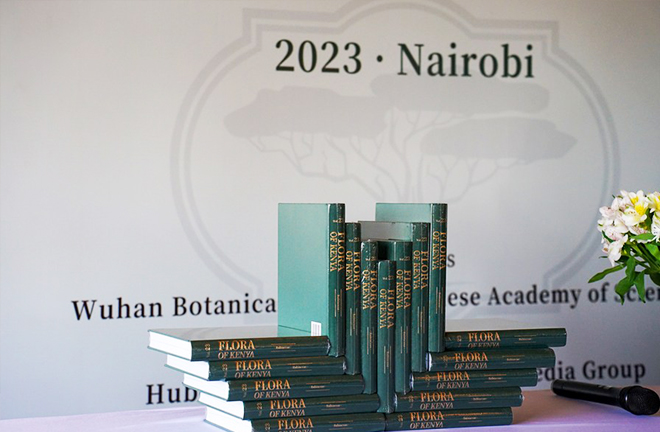China expands int’l academic cooperation

Books of the 23rd volume “Rubiaceae” of the 31-volume Flora of Kenya, displayed at the book launch in Nairobi, Kenya. Photo: XINHUA
In August 2023, Elsevier, a global leader in research publishing and information analytics, released a report stating that scientific output has grown rapidly in developing countries. The academic output of Chinese authors has been steadily increasing, with China consistently ranking first in academic output among G20 members from 2020 to 2022.
As China’s scientific research capabilities improve, an increasing number of countries are actively engaging in academic cooperation and exchanges with China, leading to a diversification of China’s academic output partners. However, certain Western countries have exhibited conflicting attitudes toward collaborating with China in scientific research. On one hand, they recognize the substantial sci-tech progress China has made, and want to collaborate. On the other hand, they have erected strict restrictions on scientific research cooperation with China.
Many international scholars and academic institutions have expressed concerns over this contradictory phenomenon. Among them, Jenny J. Lee, a professor at the Center for the Study of Higher Education and College of Education Dean’s Fellow for Internationalization at the University of Arizona in the United States, and Niels Philipsen, vice director of the Maastricht Institute for Transnational Legal Research at Maastricht University in the Netherlands, shared with CSST their views on China’s academic ties with the rest of the world and the prospects for global scientific research cooperation.
Pursuing borderless knowledge
Lee pointed out that the possible splintering of international collaboration would be problematic as the pursuit of knowledge, via scientific research, would be stymied. Addressing the world’s problems is best pursued when scientists are free and encouraged to work with leading researchers anywhere in the world, rather than for such relational configurations to be dictated by geopolitics.
“The scientific pursuit of knowledge, which is fundamentally borderless, is becoming bordered in the current geopolitical environment,” Lee said. However, on the micro level, cooperation in scientific research between China and the United States has not come to a standstill. For example, Lee surveyed about 200 collaborators in China and in the United States to see how they were able to overcome such geopolitical tensions and the challenges associated with the COVID-19 pandemic. The results of her survey revealed something unexpected.
“Basically, we found that mutual trust between international collaborators helped overcome such perceived hurdles, including risks of being unfairly targeted,” she said. “What this tells us is that a chilling effect is certainly real and remains possible, but in the end scientists have tremendous agency on what they study, where they study, and whether or not they seek funds, or where they seek funds. Regardless of the host or home country, international collaboration is important to all countries’ scientific enterprise. Coauthors from different countries improve the knowledge being produced, alongside its applicability, and enlarge global audiences, thereby increasing the impact of the work.”
Starting Dec. 1, 2023, China has implemented a unilateral visa-free policy for ordinary passport holders from France, Germany, Italy, the Netherlands, Spain, and Malaysia on a trial basis. Philipsen believes that this move will facilitate China’s international academic cooperation. It is important that there is “reciprocity,” he added, meaning that China not only sends students, guest researchers, and PhD researchers, but also invites students, PhD researchers, and senior academics from the European Union to China. The two developments represent “positive vibes” and are very much in line with the idea of reciprocity.
BRI deepens academic ties
In 2018 and 2019, Nature dispatched teams of reporters to countries participating in the Belt and Road Initiative (BRI) to explore the project’s scientific aspects. Over 100 researchers and policymakers were interviewed to assess China’s ambition to significantly expand its international research collaboration, redrawing the global science map.
For example, the Pak-Austria Fachhochschule, a collaboration between Austria, China, and Pakistan, opened in 2020, with its first students set to graduate in 2024. Meanwhile, collaborative research centers on artificial intelligence, critical minerals, and railway engineering have been established.
In September 2023, in a collaboration between the Sino–Africa Joint Research Center affiliated with the Chinese Academy of Sciences, and the National Museums of Kenya, researchers published a 31-volume study called Flora of Kenya, the first national flora of Kenya that documents nearly 7,000 plant species from 223 families.
Similarly, in October 2023, the space agencies of Pakistan and Azerbaijan announced that they will join other international partners in China’s lunar research station project, which aims to build a permanent base on the Moon in the 2030s.
At the Third Belt and Road Forum for International Cooperation, Chinese President Xi Jinping announced that “China will continue to implement the Belt and Road Science, Technology and Innovation Cooperation Action Plan, hold the first Belt and Road Conference on Science and Technology Exchange, increase the number of joint laboratories built with other parties to 100 in the next five years, and support young scientists from other countries to work on short-term programs in China.”
“It is a smart move from China to strengthen collaboration with BRI countries,” Philipsen said. “I only hope that the EU will remain neutral in all of this and will continue its collaboration with China.”
Lee predicted that as the world’s leading producer of scientific knowledge, China will inevitably increase and strengthen its relationships abroad, adding that the slowdown of China-US collaborations may open up opportunities for other parts of the world.
Edited by CHEN MIRONG
